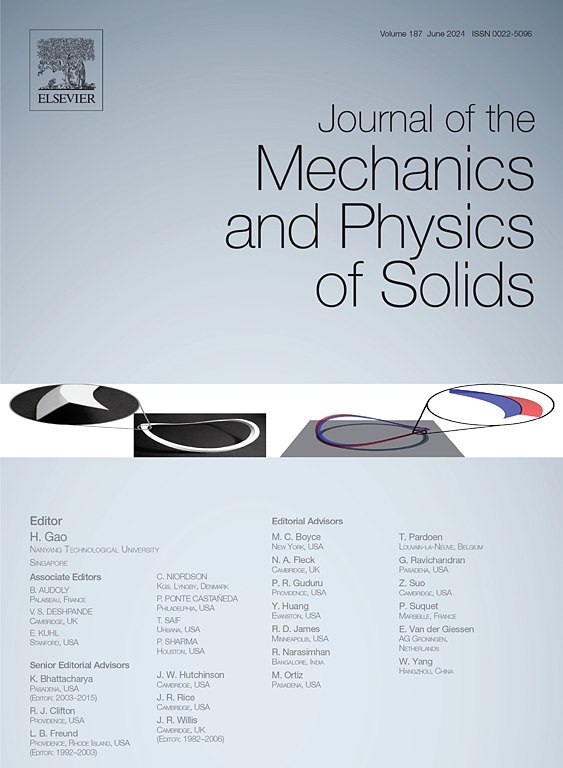A constitutive model for amorphous solids considering intrinsic entangling of shear and dilatation, with application to studying shear-banding
IF 5
2区 工程技术
Q2 MATERIALS SCIENCE, MULTIDISCIPLINARY
引用次数: 0
Abstract
In amorphous solids, shear transformations, as elementary rearrangement events operating in local regions, are intrinsically entangled with dilatation deformation, which results in the physical process of the shear band being complex. To capture such entanglement, we propose a finite-deformation continuum framework for amorphous solids by incorporating nonequilibrium thermodynamics. Within this framework, we develop a constitutive model where the thermodynamic glass is divided into the kinetic and configurational subsystems. In the model, the dilatation is attributed to an athermal expansion of configuration. As a result, the effect of shear transformation on dilatation can be considered by generating plastic cold work to change the freedom degrees of the configurational subsystem. The effect of dilatation on shear transformation can be realized through the enthalpy change of the configurational subsystem that gives rise to physical aging. Based on the proposed model, we discuss the entangling mechanism of shear and dilatation, and predict the shear-banding behaviors of metallic glasses during tensile and compressive deformations at room temperature. We reveal that due to the shear-dilatation entanglement, the elastic deformations significantly influence the evolution of configurational temperature, which plays a pivotal role in controlling the degree of strain softening and the shear-banding mode.
考虑剪切和膨胀本征纠缠的非晶固体本构模型,并应用于剪切带研究
在非晶态固体中,剪切变换作为在局部区域发生的基本重排事件,与扩张变形有着内在的纠缠关系,这导致剪切带的物理过程非常复杂。为了捕捉这种纠缠,我们结合非平衡热力学,提出了非晶态固体的有限变形连续框架。在此框架内,我们建立了一个构成模型,其中热力学玻璃分为动力学子系统和构型子系统。在该模型中,膨胀归因于构型的热膨胀。因此,可以通过产生塑性冷作来改变构型子系统的自由度,从而考虑剪切变换对扩张的影响。扩张对剪切变换的影响可通过构型子系统的焓变来实现,而焓变会引起物理老化。基于所提出的模型,我们讨论了剪切和扩张的纠缠机制,并预测了金属玻璃在室温下拉伸和压缩变形时的剪切成带行为。我们发现,由于剪切-扩张纠缠,弹性变形会显著影响构型温度的演变,而构型温度在控制应变软化程度和剪切成带模式方面起着关键作用。
本文章由计算机程序翻译,如有差异,请以英文原文为准。
求助全文
约1分钟内获得全文
求助全文
来源期刊
CiteScore
9.80
自引率
9.40%
发文量
276
审稿时长
52 days
期刊介绍:
The aim of Journal of The Mechanics and Physics of Solids is to publish research of the highest quality and of lasting significance on the mechanics of solids. The scope is broad, from fundamental concepts in mechanics to the analysis of novel phenomena and applications. Solids are interpreted broadly to include both hard and soft materials as well as natural and synthetic structures. The approach can be theoretical, experimental or computational.This research activity sits within engineering science and the allied areas of applied mathematics, materials science, bio-mechanics, applied physics, and geophysics.
The Journal was founded in 1952 by Rodney Hill, who was its Editor-in-Chief until 1968. The topics of interest to the Journal evolve with developments in the subject but its basic ethos remains the same: to publish research of the highest quality relating to the mechanics of solids. Thus, emphasis is placed on the development of fundamental concepts of mechanics and novel applications of these concepts based on theoretical, experimental or computational approaches, drawing upon the various branches of engineering science and the allied areas within applied mathematics, materials science, structural engineering, applied physics, and geophysics.
The main purpose of the Journal is to foster scientific understanding of the processes of deformation and mechanical failure of all solid materials, both technological and natural, and the connections between these processes and their underlying physical mechanisms. In this sense, the content of the Journal should reflect the current state of the discipline in analysis, experimental observation, and numerical simulation. In the interest of achieving this goal, authors are encouraged to consider the significance of their contributions for the field of mechanics and the implications of their results, in addition to describing the details of their work.

 求助内容:
求助内容: 应助结果提醒方式:
应助结果提醒方式:


